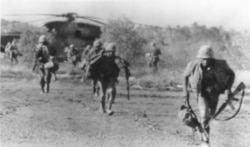Around 45 years ago, Mao Ran found himself in a boat headed to Koh Tang island. This was the first time the Khmer Rouge soldier had seen the Cambodian coastline or the Gulf of Thailand.
He still remembers being seasick in the choppy waters. The group of Khmer Rouge cadre had been told they were being transported to Koh Tral, an island off the coast of Kampot province, which is now part of Vietnam and known as Phu Quoc.
“It was the first time that I went to the sea and islands,” Mao Ran said.
Instead, the boat was headed to Koh Tang, 60 kilometers off the coast of Cambodia. Unknown to Mao Ran, he would soon be at the center of an intense battle between the Khmer Rouge cadre and the United States military personnel on May 15, 1975. The deadly fighting on the island later was dubbed by American historians as the 'Last Battle of the Vietnam War.'
A U.S. military attempt to rescue the crew of U.S. merchant ship SS Mayaguez, which had been captured by ultra-communist forces on May 12, 1975, was thwarted by heavily-armed Khmer Rouge soldiers on Koh Tang, resulting in heavy losses on both sides.
Seated at his home in Kampong Speu province’s Borseth district in April, Mao Ran now grows rice, bananas, and coconuts on a two-hectare plot of land in Pongro village.
Having lost an arm in a separate battle with Vietnamese military forces, Mao Ran told VOA Khmer he knew little of what was to unfold at Koh Tang and was only instructed to protect the island and the regime’s interests
“We didn’t know why they sent us to the island,” Mao Ran said.
“We were Cambodian soldiers and we needed to protect our territory. If they came and violated our territory, we intercepted. Whether it was wrong or right, we had to intercept first.”
On May 12, 1975, Khmer Rouge forces had captured U.S. merchant ship SS Mayaguez near Poulo Wai island, 80 kilometers from the Cambodian coastline. The container ship was headed to Thailand and, according to historians, carrying items from the U.S. Embassy in Saigon, which had fallen to Vietnamese communist forces on April 30, 1975.
According to Mao Ran, he was unaware the U.S. ship had been captured or that American nationals had been taken captive.
“At the beginning, we were not aware of the [SS Mayaguez],'' he said. “And when our soldiers got off from the ship, we knew that it was an American ship.”
The United States planned a major assault at Koh Tang on May 15 to rescue the Mayaguez and its crew. However, historians report that the Khmer Rouge had already planned to release the ship and crew hours before the U.S. rescue attempt.
“We didn’t fight on the first day,'' Mao Ran said. “We were just laying down and hiding.
Historical reports show that U.S. forces, many of them were young and yet to complete their training, came under heavy fire from Khmer Rouge forces. This resulted in two U.S. CH-53 transport helicopters being shot down by the ultra-communist soldiers, with U.S. troops pinned on two nearby beaches, unable to gain ground.
According to books written about the incident, the U.S. had to evacuate its soldiers after a day-long clash. The U.S. had already lost 23 personnel in a helicopter accident in Thailand.
The battle on Koh Tang cost the Khmer Rouge at least ten soldiers, according to historians, whereas the U.S. lost 18 soldiers on the tiny islet, three of whom were accidentally left behind during a nighttime evacuation.
Mao Ran remembered that his peers located one of the three U.S. soldiers, who was then shot on Koh Tang. “We saw the footsteps of an American soldier’s boots. He was hiding, we found him and when he was about to jump [at us], we shot him dead,” the former Khmer Rouge cadre said.
According to testimony provided to the Joint Task Force-Full Accounting, which accounts for U.S. military personnel listed as “missing in action” or “prisoners of war,” two other soldiers were also located on the island by the Khmer Rouge weeks later, taken to Sihanoukville and killed.
The battle -- four weeks after the Khmer Rouge had seized Phnom Penh and established Democratic Kampuchea -- has been mentioned in testimony provided before the U.N.-assisted Extraordinary Chambers in the Courts of Cambodia and has been documented by a local research NGO, Documentation Center of Cambodia.
Long Dany, a researcher at the Documentation Center of Cambodia, said Khmer Rouge soldiers he interviewed admitted that they did not have knowledge about international maritime law.
“They said it was a mistake that the Khmer Rouge intercepted the ship in the international maritime,” he said.
The researcher added the event could have been averted had both sides been better at information gathering.
“There was confusion in receiving information,” Long Dany said.
Elizabeth Becker, an American journalist who lived and worked in Cambodia in the mid-70s and later authored “When The War Was Over,” said the SS Mayaguez’s incursion into Cambodian waters happened to coincide with the Khmer Rouge’s recent victory in Phnom Penh, leading to nervousness over the ship’s intentions.
“Then both sides overreacted,” she said in an email. “It was a tremendous loss of life and is considered by the U.S. as the ‘last battle of the Vietnam War.’”
Mao Ran pegs the intense incident to Khmer Rouge and U.S. soldiers courageously standing their ground and following orders, but believes the U.S. was ultimately the provocateur.
“Who was wrong and who was right? It was hard to say,” he said. “If I were to hypothesize, the U.S. was wrong because we intercepted their [ship in Cambodian waters]. We didn’t mistreat them, even though we intercepted their ship.”











